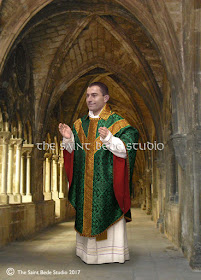In a
previous post, we introduced why
altar frontals or
antependia are desirable to cloth altars, based on liturgical law, sacred symbolism and aesthetics. These are compelling reasons for the use of the frontal, but so frequently two objections are offered why the altar frontal is
not used :
The altar is so beautiful, why would we cover it up?
It is too difficult to be changing frontals frequently.
The answers to the first objection may be found by
re-reading our first post. But in this article we wish to begin to discuss the second objection.
 |
A splendidly designed and embroidered altar frontal
clothing the High Altar of Westminster Cathedral (UK).
The use of the original High altar for the celebration of the Sacred Liturgy
was reintroduced by the present Archbishop of Westminster,
shewn in the photograph offering Mass. |
Firstly, some terminology. The words
frontal and
antependium presuppose that the covering is applied only to
one face of the altar namely, the front of it. This is perfectly proper when considering an altar which is attached to a reredos, or very close to a wall and therefore not freestanding. An altar, however, is a three-dimensional structure and - if it is freestanding - it ought to be fully clothed, not just clothed on those sides which are generally visible. Consequently, we also find the term
altar pall which describes a parament which covers
all sides of the altar or, at the least, two of them, the front face and the back face.
A free-standing altar placed in a central position which can be viewed from all sides, requires coverings at the front and the back (we leave aside the question of the linen altar cloths) in order for the covering to fulfil its purpose. It is unseemly to cover the front and not the back of an altar, unless of course, one takes the view that the altar frontal is purely used for aesthetic effect.
Where possible, and for reasons of
adequately expressing sacred symbolism, the altar pall or frontal ought to be changed in accordance with the colour of the Liturgical Day or Season. It is quite acceptable, however, to have a worthy form of altar pall which is changed hardly ever. It is when several frontals or palls are used and have to be changed that the second objection becomes more prominent.
At present, as in the past, very few altars are designed with any thought given to their being covered with a pall or frontal. This is a serious deficiency in the vision of designers, but it is hardly a new one.
It is very important when designing altars that serious consideration is given as to how they will be clothed. If no arrangement, or a clumsy arrangement is made for clothing an altar with a pall, quite quickly this will be cited as the reason NOT to use an altar pall or frontal. "It's too much trouble".
We will pass over without comment those execrable and unbefitting creations which, being multi-sided instead of four-sided, arrogantly defy sacred Tradition and any form of altar covering.
To be continued ...








